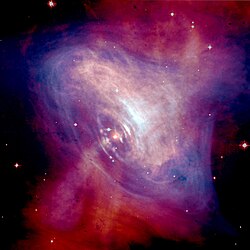
Back Pulsar Afrikaans Pulsar AN نباض Arabic Púlsar AST Pulsar Azerbaijani Пульсар Byelorussian Пульсар BE-X-OLD Pulsar BJN পালসার Bengali/Bangla Pulsar BS


Pulsars [1] are neutron stars which spin rapidly and produce huge electromagnetic radiation along a narrow beam. Neutron stars are very dense, and have short, regular spins. This produces a very precise interval between pulses that range from roughly milliseconds to seconds for an individual pulsar. The pulse can only be seen if the Earth is close enough to the direction of the beam. Similar to how you can only see a lighthouse when the beam is shining at your direction.
The pulses match the star's turns. The spinning causes a lighthouse effect, as the radiation is only seen at short intervals. Werner Becker of the Max Planck Institute for Extraterrestrial Physics recently said,
- "The theory of how pulsars emit their radiation is still in its infancy, even after nearly forty years of work. There are many models but no accepted theory".[2]
- ↑ coined word from pulsating star
- ↑ European Space Agency, press release, Old pulsars still have new tricks to teach us, 26 July 2006